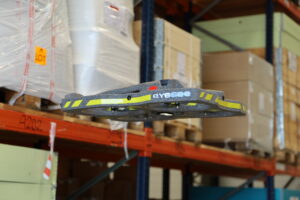What is the cycle counting inventory ?
Effective inventory management is a crucial pillar of the supply chain, directly influencing the profitability and efficiency of operations. At the core of this management is the obligation to conduct an annual stock inventory to substantiate, from a tax perspective, the accuracy of the evaluation of the assets and liabilities of the company’s heritage.
Beyond this regulatory necessity, stock inventory serves primarily to generate various performance indicators to optimize the supply chain effectively.
To meet this legal requirement, businesses have the option to choose from several inventory methods, each presenting its own advantages and disadvantages: annual inventory, cycle counting inventory, periodic inventory, or perpetual inventory.
But, what is cycle counting? What is its role, its advantages? How can it be implemented to optimize your operations?
Annual inventory or cycle counting : which one to choose ?
The annual inventory is an inventory conducted 1 to 2 times a year, often close to the end of the financial statement period. It involves taking stock of all inventory in a warehouse and is considered the traditional inventory method.
Conducting an annual inventory can be a good choice for businesses with limited stock or whose operations can be temporarily halted without significant disruption. During an annual inventory, the entire stock must be scanned in a short period, often requiring a complete interruption of all logistical activities and the allocation of significant financial resources (such as renting lifts, mobilizing personnel, etc.).
To audit the entirety of an inventory in a medium-sized warehouse (18,500m²), with an average of 120 locations scanned per hour, it would require:
- Halting production for a full 3 days, with 8 hours per day of inventory time.
- Mobilizing 12 full-time personnel.
- Renting 6 forklifts.
On the contrary, cycle counting, by segmenting inventory activities, allows for partial inventories of the warehouse throughout the year, ensuring the continuity of logistical activities. Requiring annual planning, it particularly enhances the performance of the logistics warehouse by:
- Improving inventory accuracy.
- Accelerating the detection of defective items.
- Providing indicators that can support strategic decisions (unknown shrinkage).
- Allowing for monitoring of stock levels and preventing overstock or stockouts.
These two approaches can complement or substitute each other: many companies implement cycle counting in addition to an annual physical inventory to have complete control over their inventory process. It’s also possible to replace the legal annual inventory with cycle counting. In this case, the inventory procedure must be validated by an auditor who ensures the reliability of the implemented inventory process.
Cycle Counting: Essentials for implementation !
You’ve made the decision to implement cycle counting as a complement or replacement for your traditional inventory processes! What are the different methods and steps to ensure the effectiveness of your cycle counting?
Key elements to consider when creating your procedure
The implementation of a cycle counting requires thorough planning. To establish a reliable and effective procedure, it is essential to consider:
Number of References: Determine in advance how many references are stored in the logistics warehouse. Among these references, you can identify, for example, the number of high-value products, products that require more frequent verification, or products based on their location (references stored at height or in picking areas).
Available Resources for Inventory: Estimate the number of employees and the time they can allocate to stock counting.
Time Windows for Cycle Counting: Depending on the industry, certain time frames may be more suitable for cycle counting, such as late afternoon when the bulk of the day’s logistic flow has passed.
Counting Frequency: Evaluate how often you want to check your stock references.
Various methods of cycle counting
To enhance stock control, you can employ different cycle counting methods, such as:
ABC Counting: Based on the Pareto principle (20% of references represent 80% of sales), this is one of the most commonly used techniques. Products are classified into different categories: Category A items represent references that generate a significant portion of revenue, Category B items account for 25% of references and 10% of revenue, etc. Categories can be defined based on sales volume or the market value of products. Subsequently, the counting frequency for different categories needs to be determined (counting high-volume or high-value products may be beneficial as these references have the most impact on business).
Counting by Physical Area: Independently of references, the warehouse is divided into several zones (e.g., aisles). The counter is responsible for checking all references in their assigned zone.
Control Group: Involves counting a small group of references multiple times over a very short period to reveal errors in counting techniques.
Random Sampling: Random selection of several references to be counted. This counting can be done daily to ensure the reliability of the stock.
Most companies combine these methods in a hybrid approach to achieve the most accurate results possible.
Automating Cycle Counting in addition to or instead of annual fiscal inventory : available warehouse tools
Implementing a cycle counting process can be tedious: automating all or part of your process can significantly improve inventory accuracy and enable you to generate reliable indicators.
Moreover, in addition to its precision, automation can also help reduce labor costs (fewer workplace accidents, increased productivity) and ensure better visibility into the state of your stocks.
Various solutions are available to automate your inventory, including:
- Specific features developed by Warehouse Management Systems (WMS).
- Installation of a connected infrastructure in the warehouse.
- The use of inventory robots or drones.
Using the EYESEE inventory drone in your processes
We have designed the EYESEE inventory drone solution to streamline and enhance inventory processes, particularly cycle counting.
Its primary operation is based on physical area counting (although reconnaissance missions are possible) of full SKUs (wrapped and complete pallets).

Due to its lightweight design and infrastructure-free operation, it can be moved from aisle to aisle and can scan an average of 500 locations per hour. Therefore, its use is suitable for both annual fiscal inventory and cycle counting.
Its capability to operate up to 20 meters in height also facilitates internal organization: there is no need to reserve or rent lifts to scan high locations, making it particularly easy to use in concurrent activities and, thus, in cycle counting.
Several users of the EYESEE solution have transitioned their internal processes to cycle counting. If you would like to discover all the benefits of implementing an EYESEE drone, feel free to contact our teams or fill out the form below to assess the eligibility of your logistics site.









